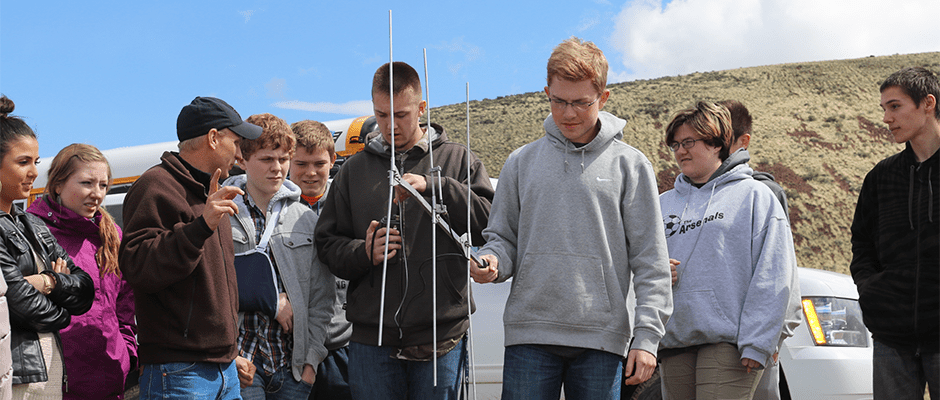Share this article
UM Student Chapter expands education offerings
This article originally appears in the University of Montana Student Chapter’s September/October 2018 newsletter.
A stuffed animal sits in a small mammal trap on the grounds of a local elementary school. Kids run a pit tag reader over the fluffy, plush critter to find out what they “caught,” while volunteers from the University of Montana Student Chapter of The Wildlife Society look on. This activity is part of the “Wild Jobs” education program that aims to teach kids about careers in the wildlife field.
This semester, the student chapter began offering a regularly scheduled education program instead of sporadic events. Education officer, Jonathan Karlen, a sophomore, spearheaded the effort to establish a program.
Karlen has a real passion for science education. While working with the Clark Fork Watershed Education Program, he realized the need for science education in area schools. “Montana is adopting new science standards for public schools, but there is still a very strong need to make science fun and exciting for students, and we, as college students, have the ability to do that in an especially impactful way,” he says.
This year, Karlen reached out to the director of the Western Montana Mental Health Center, and asked if the student chapter could join the Flagship Program.
Flagship is a nonprofit afterschool program free to all students. Last year the program reached 1,658 individual kids with its afterschool education offerings. It’s focused on eight Missoula-area schools. The program gives kids a place to be after school, provides them with mentors and gives them an outlet for learning new skills.
So far, the student chapter has given two Flagship programs and has six programs coming up, two in middle schools and four in elementary schools. They’ve also done an extended “Wild Jobs” program for a homeschool group.
Volunteers are always needed for the programs, and they gain excellent outreach experience to put on their resumes and build their skillset.
Karlen stresses the importance for a wildlife biologist to learn to communicate science to a general audience. “You could be a brilliant researcher publishing papers, but if you can’t simplify it and explain it, it isn’t reaching its full potential,” he said. “The general public isn’t reading the Journal of Applied Epidemiology.”
Not only does it build skills for volunteers, the programs are a blast, and the kids get a lot out of them. They learn how to use radio telemetry techniques that many of them know of only from the Discovery Channel.
The volunteers hide the transponders on the school grounds. Sometimes a competition to find the transponders ensues, or the volunteers try to throw the kids off the trail. Some kids have even climbed the playground equipment to get a better signal.
The volunteers also offer a “Be Bear Aware” Program. They partner with program leader Chuck Bartlebaugh, who brings his mounted grizzly and black bears. This year, Murdoch’s donated inert bear spray so that the kids could practice taking the safety off and spraying the cloud. “That’s cool because they’re in the schoolyard spraying bear spray with two actual bears,” says Karlen.
Karlen is looking to expand if other opportunities arise. He hopes that other organizations in town will see what they have going on and be interested in being a part of it. “If they feel like their programs will benefit from us coming in, we’d like to do that,” he says.
Having the skills to communicate science simply and clearly can’t be stressed enough if you’re a biologist, and talking to kids is a great way to improve those skills. “If you can explain bioindicators and biodiversity to a third grader, then you can take those skills and explain that to a roomful of people really angry about your wolf management decision,” Karlen says.
It’s easy to get involved at various levels from just helping out, to leading programs as a volunteer.
Karlen currently has two volunteers set up to lead programs on their own. “I’m hoping to get students to make this program their own, and if they have a special interest in an animal or an area of wildlife, to develop their own curriculum and deliver that,” says Karlen.
If you are interested in learning more about Flagship or in volunteering, email the student chapter at umwildlifesociety@gmail.com.
Header Image: High school students learn how to use radio telemetry. ©USFWS Pacific Region








